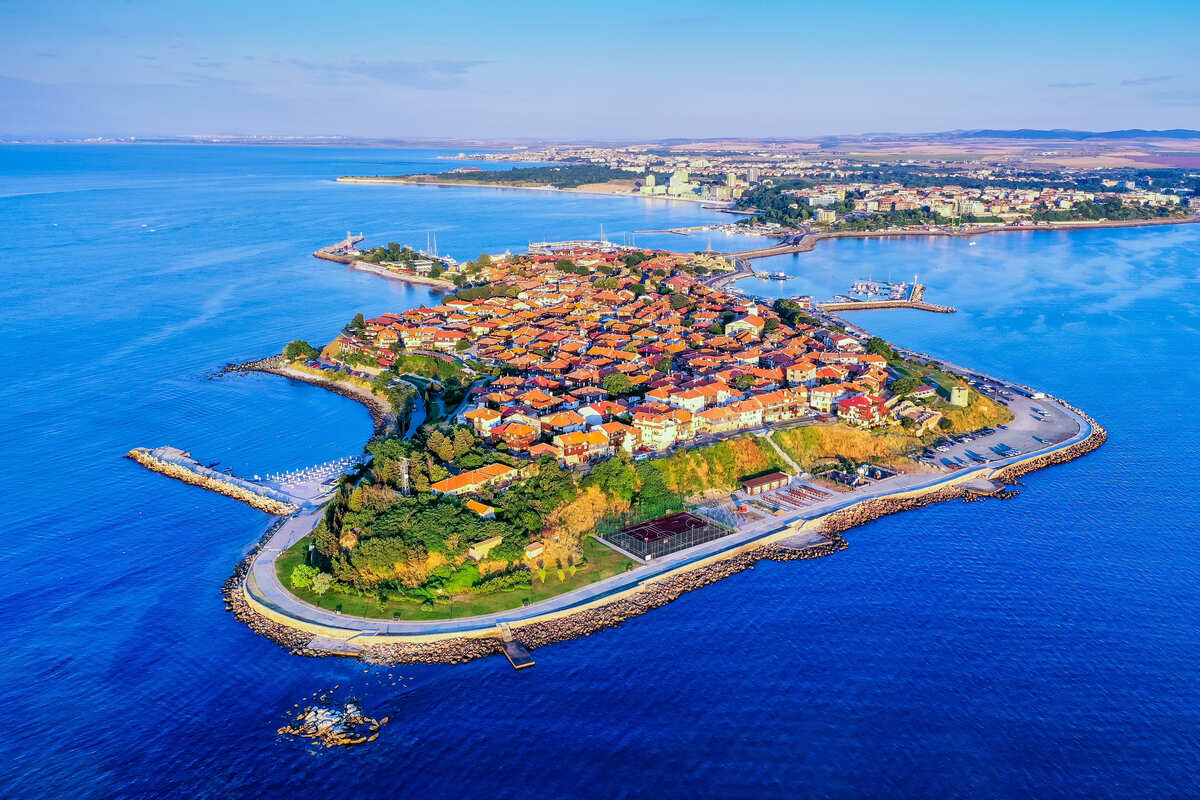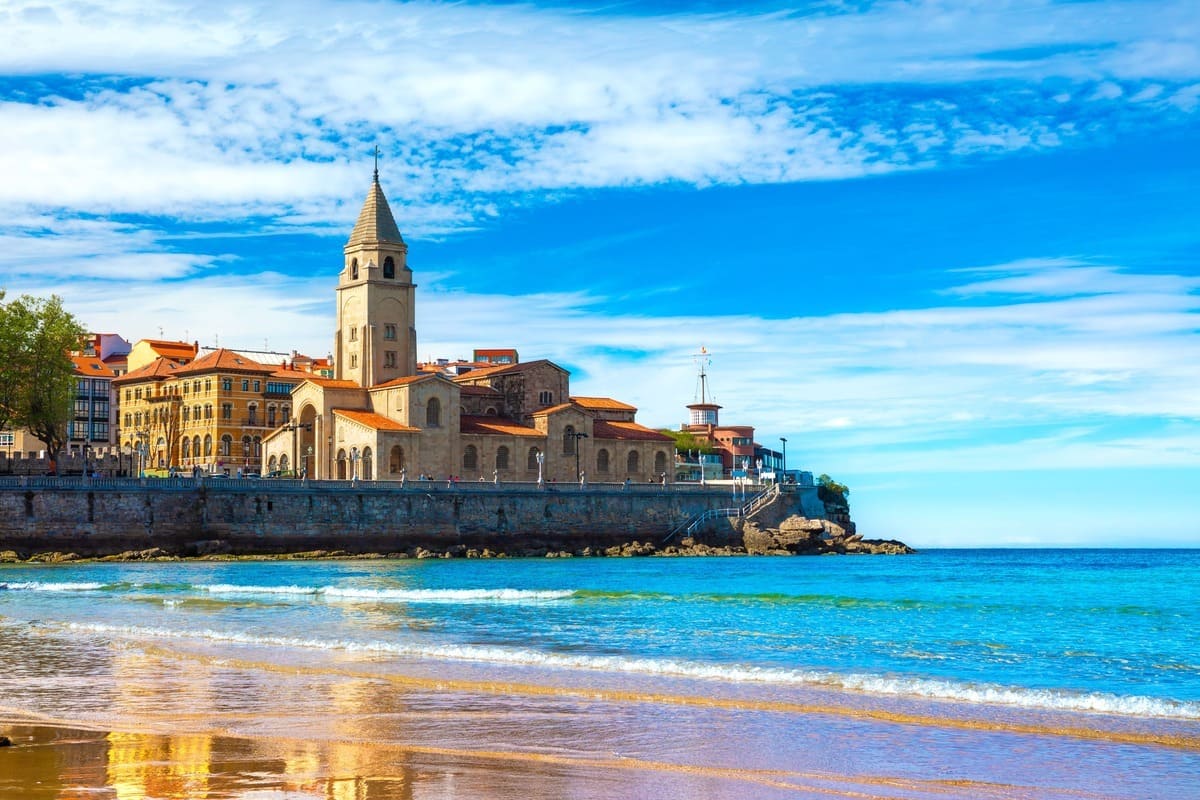In this video, prepare for the worst on holiday when travelling to Spain this Summer in 2025. I highlight the importance of travel …
source
Prepare for the WORST on Holiday in 2025 [Travelling to Spain]


In this video, prepare for the worst on holiday when travelling to Spain this Summer in 2025. I highlight the importance of travel …
source

[ad_1]
We all know Spain for its scenic Mediterranean coast, interspersed with vibrant resort cities and hugged by crystal-clear seas, but if you’ve been to the Iberian country in the past three or four years, you’ve probably noticed how shockingly expensive and busy it’s become.
From an average overnight rate of $201 in Barcelona to unsustainable levels of overtourism in the trendy vacation island of Mallorca, where anti-tourist sentiment has been dangerously brewing, we wouldn’t be the first in line to board that flight.
Luckily, there’s an exciting Spain dupe tucked away in the much more offbeat, lesser-known Southeastern corner of Europe causing quite the commotion lately, and if we must add, it’s way cheaper and less crowded:

When you think of Bulgaria, you probably conjure up images of wintry landscapes, Soviet-style concrete blocks, and Orthodox piousness.
While there is some truth to that, something most people don’t know is that it turns into a summer paradise in the warmer months.
Were you even aware that Bulgaria’s coastline on the Black Sea extends for an uninterrupted 235 miles and is lined with quaint beach towns that just couldn’t be further apart from the stereotypical grayed-out, war-torn version of Eastern Europe?
Or that, for instance, it’s about as warm as the Mediterranean, if not warmer?
We kid you not:

Some cities along the coast have an average daily maximum of 84.2°F and lows of 66.2°F, and if you’re pondering whether to pack an extra jumper or two ‘just in case’ it gets chilly, baby, you better save space in your carry-on for some more swim shorts instead.
Not to brag, but no other travel news website stays on top of travel trends like Travel Off Path, and we reported a couple of years ago on how the Black Sea is a new Mediterranean in the making, and we’re glad to see others are finally catching on:

This year, The New York Times featured this part of the world in their list of ‘best places to travel’ in 2025, while CEO for Europe-based travel agency TUI was recorded stating Bulgaria ‘could rival holiday hotspots such as Mallory and Menorca’ in summer.
Newcomers are also taking to social media in droves to showcase Bulgaria’s beauty: on TikTok alone, the hashtag #bulgaria alone has racked up over 2.5 million posts.
Users will share their captures of sandy beaches, sleepy coastal villages that seem frozen in time, and stunning nature yet to meet the spoils of mass tourism.
Some of the most popular TikTok’s, however, refer to Bulgaria’s affordability as a beach destination, compared to Spain, Italy or Greece.
This post by TikTok user @heroiisa in particular highlights Varna as an inexpensive summer getaway, where accommodation prices range from only $8 to $30-a-night, meals cost between $5 and $12 in local restaurants, and the beaches look untarnished, with crystal-clear waters:
@heroiisa BUDGET TRAVEL GUIDE TO VARNA, BULGARIA✈️ Varna is one of the best places to visit when you are young and on a budget!✨ All prices are in USD and based on a realistic budget for BUDGET travelers in Varna, Bulgaria💸 🏨Accommodation: $8 to $30/night per person if you stay in a hostel dorm or share an apartment or a double room in a cheap guesthouse/hotel with someone. This depends on the season, the lower end of the prices is for shoulder season (April-June or September-October) and the higher end for high season (July-August). 🍛Food: there are plenty of options for $5 to $12/meal. If you cook, you can do it even cheaper than this! ☀️Activities: $0-20 depending on what you want to do! I didn’t spend much money on activities in Varna because there are many free things to do but there are also some paid activities you can do depending on your budget. 🚌Getting there: You can get to Varna by bus or train from other popular Bulgarian destinations and cities like Sofia, Burgas, or Plovdiv. Bus and train tickets depend on the route but are usually very affordable ($2-12). ✈️Flights: When it comes to flights, you can fly into Burgas, Sofia, Plovdiv, or Varna from many European cities with Ryanair or Wizz Air and then take public transportation to Varna. It’s also an option to fly somewhere else in the Balkans and take public transportation from there if you have time for a longer trip.
That’s an account by a single traveler, but Budget Your Trip, our own preferred platform for tracking prices across different countries, corroborates that Bulgaria is indeed on the cheaper end when it comes to summer destinations.
More specifically, tourists will spend an average $27 on meals per day, unless they’re traveling luxuriously (in that case, they should budget $73), and $72 on hotels, for total week-long travel expenses of $1,076 for two people (or the equivalent in Bulgarian lev).

There are countless world-class destinations to pick from if you’re skipping Spain and heading to Bulgaria this year.
If you seek Old World charm and culture, visit the picture-perfect, cobbled Nessebar. This walled city occupies the end of a narrow peninsula and has a rich history dating back several millennia and comprising periods of Thracian, Greek, and Roman rule.
Its ensemble of Byzantine churches and fortifications are a UNESCO World Heritage Site, and the hotel-lined South Beach, a short drive from the Old Town, has been awarded Blue Flag status, owing it to its cleanliness.
Looking for a traditional beach getaway instead, Mallorca-style?

Sunny Beach is not an island, though it is, as the name indicates, a sun-drenched resort development unfolding along an azure Black Sea packed with beach bars, where beer costs as cheap as $2, and a waterfront 3-star Hotel Zaara will only set you back by $35-a-night.
Keen on an all-inclusive deal instead?
HI Hotels Imperial Resort has nightly rates from a shockingly affordable $80 this June, all meals included, and access to all resort areas, including the pool and fitness center.
We’re not going to lie to you: Sunny Beach can get a bit crowded in summer, not due to an influx of foreign tourists but due to its popularity with Bulgarians (and the neighboring Romanians) themselves. So, for some peace and quiet and more exclusivity, there’s Sveti Vlas to the northeast.

A laid-back yacht marina boasting a plethora of dining options, and several long miles of untouched fine, golden sands, it has 5-star hotels from $66 per night––check out the Garden of Eden Complex.
For a city break, our top picks are Burgas and Varna, the largest conurbations on the Bulgarian coast, and two bustling Black Sea ports famous for their ancient heritage––even the Starbucks in Varna is built on top of Roman relics!––and thriving nightlife.
They’re also the gateway to the coast, hosting low-cost flights from numerous European destinations in the high season, starting in May.
↓ Elevate Your Travel↓
Sign Up Now For Travel Off Path Premium! No ads, VIP Content, Personal Travel Concierge, Huge Savings, Daily Deals, Members Forum & More!

✈️Join Our Travel Off Path Community Forum: Where travelers unite, ask questions, share experiences and even find like-minded travel buddies!
Enter your email address to subscribe to Travel Off Path’s latest breaking travel news, straight to your inbox.
This article originally appeared on TravelOffPath.com
Opinions expressed here are the author’s alone, not those of any bank, credit card issuer, hotel, airline, or other entity. This content has not been reviewed, approved or otherwise endorsed by any of the entities included within the post.
[ad_2]
Source link

[ad_1]
Last Updated
While you’re likely to be well-familiarized with the likes of Barcelona, Mallorca, and Gran Canaria, we’re pretty sure you haven’t heard of Asturias, or if you did, you promptly brushed it aside as it’s not, you know, your usual beach hotspot.
Gross mistake.
As it turns out, Asturias is currently one of the fastest-rising Spanish destinations in popularity, recording a 17% uptick in visitors this winter alone even though it’s the low season and being expected to host a record number of guests throughout 2025.

Now that we’ve piqued your curiosity, what is Asturias all about, and why is everyone suddenly this interested in an offbeat, largely rural region in the much-underrated North of Spain?
Officially called the Principality of Asturias, this is a historically significant region in northwest Spain characterized by its dramatic coastline, interspersed with sandy beaches and tall sea cliffs, mountainous hinterland, and medieval heritage.
Asturias was one of a handful of regions in the Iberian Peninsula––which includes Spain and Portugal––not to have fallen under Muslim control during the Arab takeover of Spain, which lasted for over 7 centuries.

As a result, it’s retained a distinct culture from that of the rest of the country: for instance, it’s still a principality, as the name indicates, with Felipe VI currently bearing the title of Prince of Asturias, and for many centuries, it was considered Spain’s last true Christian stronghold.
Until, of course, the country was reclaimed by the Christians, and this leads us to our first stop on this journey around Asturias:

The regional capital is Oviedo, a mid-size city dating back to the Middle Ages, home to the monumental Oviedo Cathedral, one of the most beautiful Gothic monuments in Northern Spain, picturesque plazas bordered by restaurants, and many museums.
The 9th century Iglesia de Santa María del Naranco is a UNESCO World Heritage Site, in recognition of its intact state for a Romanesque structure that is ancient, while Plaza del Fontán has its own traditional market.

If you’re an art geek, the Museum of Fine Arts of Asturias, located in Oviedo, has a vast collection of European pieces ranging from the Spanish Middle Ages to 20th century Flemish, and for the best fabada in town, make sure you book a table at Taberna Salcedo.
Asturian cuisine is one of the tastiest and most diverse in Spain, and from its white-bean-based dishes to pork shoulder (locally known as llacón), to the usual Northerly chorizo and the hearty Asturian stew, Oviedo’s food scene will not disappoint you.

As beautiful as Oviedo may be, you’ll want to head to the Asturian seaside to truly take in the region’s most authentic culture: unfolding along an azure Atlantic for roughly 250 miles, it is lined with vibrant port cities, quaint fishing towns, and picture-perfect beaches.
Let’s start with the main coastal city in Asturias, as well as its largest one, at that (yep, larger even than Oviedo).
From spring, when it’s warm enough, Gijón is the perfect mix of beaches and culture, with its centrally-located Playa de San Lorenzo being hugged by the crystal-clear seas of the Bay of Biscay, and the colorful harbor houses that have barely seen the passing of time.

Over in Llanes, a laid-back seaside resort, you’ll find an unspoiled Playa de Guadamía, nestled between cliffs, and if you’re driving out to Playa de Griega, near the small settlement of Colunga, you’ll get the chance to see fossilized tracks left by dinosaurs.
Then there’s Gulpiyuri a unique inland swimming site near a flooded sinkhole, said to be the smallest beach in the world and a well-frequented Playa de Torimbia, straddling the ocean for what seems like endless miles.
While we’re still on the coast, it’s time to tour Asturias’ prettiest seaside settlements:

Some of the prettiest small towns in Asturias include Cudillero, a quaint village on the Bay of Biscay and a perfect photo op for tourists thanks to its colorful houses, narrow streets, and a marina filled with fishing boats.
Luarca is just as pretty, with a well-preserved center dating back centuries and its fair share of unruffled sandy beaches (not to mention a landmark lighthouse), but if attending the world’s oldest canoe festival happens to be on your bucket list, it’s Ribadesella where you should be headed:

It hosts the annual Descent of the Villaviciosa River, taking place in early August this year, not to mention it has a charming historic center packed with family-run eateries (it’s a bit out of town, but don’t sleep on Meson Sidreria‘s pochopo).
Now that you’ve had your fair share of Instagrammable corners and colorful harbors, ready to put your hiking boots on?

For the hiking enthusiast amongst us, you’ll be thrilled to learn Asturias is one of Europe’s top hiking hotspots, largely due to its Picos de Europa, which cuts through its undeveloped terrain and provides sanctuary for a variety of wildlife.
Brown bears, wolves, eagles, you name it.
It’s also littered with skiing stations for winter, but we’d argue it’s far more beautiful to visit from spring onward when the peaks are clad in lush green, the birds are out, and all footpaths and trails are again accessible.
When the time comes, you’ll be able to join thousands of pilgrims on their way up the peaks to the Sanctuary of Covadonga: Asturias was, for many centuries, Spain’s last Christian outpost, remember?

We should probably mention this sanctuary, perched atop a prominent hill, surrounded by the snow-dusted elevations of Picos de Europa, provided the background for the first battle of the Reconquista, the period relating to the Christian reconquest of Spain.
Other than holding sentimental and religious value for Christian Spaniards, it is famous for its tiny chapel built into a cave with a lake underneath.
For more breathtaking natural scenery, head next to the Somiedo National Park, where many more hiking opportunities and deep-turquoise, high-elevation lakes await, and Las Ubiñas-La Mesa Natural Park, the second largest mountain range in Asturias.
Finally, just how Expensive Is Asturias?

As it is yet to be engulfed by tourism in the way Catalonia, the Balearic Islands, or the Canaries have, Asturias continues to offer visitors a justly-priced alternative to Spain’s beach hotspots.
Believe it or not, booking a standard double room in an Ibis in central Oviedo will set you back by $37-a-night, while the average price of a meal in an inexpensive local restaurant––frequented by Asturians themselves––is $15.47, according to Numbeo.
If you’re keen on hiking the Picos de Europa, Cangas de Onís is the base you’re looking for: a small town nestled in a valley, where some of the most popular trails start from, it has a 5-arched, ancient Roman bridge over a crystalline river, and it’s a safe haven itself for the park’s golden eagles.

The Puente Romano guesthouse, only a few steps from the Roman bridge, costs $41 per night.
Staying by the seaside instead? A private room at the seafront Hostel Gijón Centro, within walking distance of San Lorenzo Beach and the lively port, averages $41 again.
As El Comercio notes, the popularity of the Principality can be attributed not only to its overlooked cultural value and breathtaking nature but also to the rising temperatures seen across Spain.

You see, Asturias is Spain, indeed, but with a different flavor of it: it’s in the North, it’s very mountainous, and most importantly, it isn’t on the receiving end of the scorching heatwaves emanating from North Africa, like Malaga or Barcelona are.
The fact it is not a Mediterranean destination has, in fact, played in its favor, as its coast has a temperate climate in summer, rarely reaching unpleasant highs of over 86.0°F, and the mountains are always cooler, irrespective of the season.
If you can’t bear the Southern European heat, you should know weather-wise, Asturias more closely resembles Northwestern Spain or even Southern England (in the warmer months).

Beginning this year, Americans can fly nonstop to Bilbao, the largest city in the neighboring Basque Country, for the first time ever.
The Basque Country is just as fascinating and underrated a part of Spain to discover, yet if you’re intent on reaching Asturias on your next getaway, which we wouldn’t blame you for after seeing all it has to offer, you can land in Basque, and then make your way west to Asturias.
The driving distance from Bilbao to Oviedo is roughly 3 hours, and you’ll be passing by some of the most spectacular scenery both in Basque Country and in Asturias in between.

Alternatively, you have more flight options landing in Madrid, where high-speed trains to Asturias (namely Oviedo or Gijon) are available from as cheap as $17 one-way.
If landing elsewhere in Spain or Europe, you can fly to Asturias Airport, located 9 miles from Avilés, 24 miles from Gijon, and 29 miles from Oviedo.
Flights are offered from many European hubs that host transatlantic flights, and Americans can get to them nonstop, such as Frankfurt and Munich in Germany, Lisbon in Portugal, London (Gatwick) in England, and Paris (Orly) in France.
Low-cost airlines such as Volotea and Vueling service some of these routes, with tickets starting from a shockingly-cheap $17.
↓ Elevate Your Travel↓
Sign Up Now For Travel Off Path Premium! No ads, VIP Content, Personal Travel Concierge, Huge Savings, Daily Deals, Members Forum & More!

✈️Join Our Travel Off Path Community Forum: Where travelers unite, ask questions, share experiences and even find like-minded travel buddies!
Enter your email address to subscribe to Travel Off Path’s latest breaking travel news, straight to your inbox.
This article originally appeared on TravelOffPath.com
Opinions expressed here are the author’s alone, not those of any bank, credit card issuer, hotel, airline, or other entity. This content has not been reviewed, approved or otherwise endorsed by any of the entities included within the post.
[ad_2]
Source link